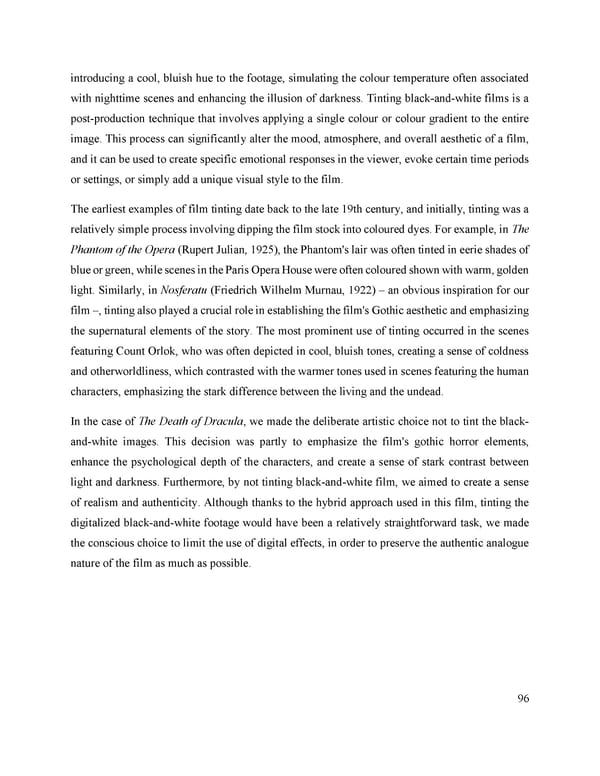introducing a cool, bluish hue to the footage, simulating the colour temperature often associated with nighttime scenes and enhancing the illusion of darkness. Tinting black-and-white films is a post-production technique that involves applying a single colour or colour gradient to the entire image. This process can significantly alter the mood, atmosphere, and overall aesthetic of a film, and it can be used to create specific emotional responses in the viewer, evoke certain time periods or settings, or simply add a unique visual style to the film. The earliest examples of film tinting date back to the late 19th century, and initially, tinting was a relatively simple process involving dipping the film stock into coloured dyes. For example, in The Phantom of the Opera (Rupert Julian, 1925), the Phantom's lair was often tinted in eerie shades of blue or green, while scenes in the Paris Opera House were often coloured shown with warm, golden light. Similarly, in Nosferatu (Friedrich Wilhelm Murnau, 1922) – an obvious inspiration for our film –, tinting also played a crucial role in establishing the film's Gothic aesthetic and emphasizing the supernatural elements of the story. The most prominent use of tinting occurred in the scenes featuring Count Orlok, who was often depicted in cool, bluish tones, creating a sense of coldness and otherworldliness, which contrasted with the warmer tones used in scenes featuring the human characters, emphasizing the stark difference between the living and the undead. In the case of The Death of Dracula, we made the deliberate artistic choice not to tint the black- and-white images. This decision was partly to emphasize the film's gothic horror elements, enhance the psychological depth of the characters, and create a sense of stark contrast between light and darkness. Furthermore, by not tinting black-and-white film, we aimed to create a sense of realism and authenticity. Although thanks to the hybrid approach used in this film, tinting the digitalized black-and-white footage would have been a relatively straightforward task, we made the conscious choice to limit the use of digital effects, in order to preserve the authentic analogue nature of the film as much as possible. 96
 Lost Analogue: Exploring Film, Music, and Interdisciplinary Methods in Education Page 96 Page 98
Lost Analogue: Exploring Film, Music, and Interdisciplinary Methods in Education Page 96 Page 98